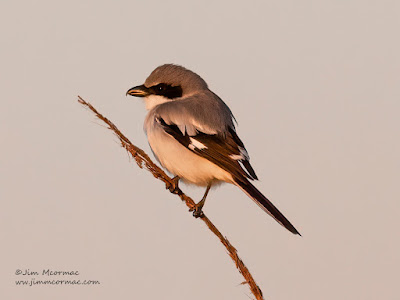I found the above bird near Jupiter, Florida, on January 14, 2022. Fortunately, shrikes are still somewhat common down there and not too tough to find. This bird was conspicuous as it teed up in prominent places, frequently calling. I watched it for some time, hoping to see it score a kill. It only made one attempt while I was there, chasing a Song Sparrow into the dense crown of a palm. The lucky sparrow escaped.
Potential prey that eludes a shrike are lucky indeed. They aren't nicknamed butcherbird for nothing. Probably due to their short legs and lack of talons, which makes it tough for the predatory songbirds to both hold victims and dismember them simultaneously, shrikes employ another tactic. They typically impale the victim on thorns, barbed wire, or other sharp objects. Once the prey item is so secured, they rip into it with a powerful raptorial bill. There was some barbed wire nearby, and I confess to having visions of the shrike using it to shish kabob that sparrow. On the other hand, I'm kind of glad the sparrow escaped. But I was a dispassionate observer, standing by to document whatever might happen without imposing my will.
Loggerhead Shrikes used to be uncommon but fairly widespread in Ohio. A number of times, in my younger days, I ran across them unexpectedly in rural areas. Always a great find, but certainly not an earth-shattering rarity. By 1980, their status had changed, much for the worse. By then, Loggerhead Shrike was a bonafide rarity, and it is even more so today. There may only be a few breeding pairs left in the state and the Ohio Division of Wildlife lists it as endangered.
The radical shift in agricultural practices undoubtedly played a big role in the shrike's demise. Mostly gone are the once common farms filled with meadows, shrubby fencerows, and other vestiges of non-crop habitat. Shrikes and many other bird species did well in the farm-scapes of yore. Today, it's mostly large industrial-scale agriculture with barely a trace of native flora and fauna.
The Loggerhead Shrike, in northerly latitudes such as Ohio, was a boom-and-bust species. It clearly colonized the state on the heels of deforestation and the opening up of the landscape. For several decades, the vegetation structure was conducive to shrikes and they peaked from around 1880 into the 1930's, but their heyday was short-lived in the big scheme. Loggerhead Shrike is not the only southern boom-and-bust species that has now vanished (or nearly so) from Ohio. Bachman's Sparrow and Bewick's Wren are two others that mirrored this pattern.
Fortunately, the fascinating and charismatic butcherbirds are still doing pretty well in the southern and westerly regions of their range. And if you're an Ohio birder, that's probably where you'll have to go to see them, at least in any numbers.

3 comments:
Hey, Jim--
Thanks as always for your pbservations!
I'll give an Amen to your final sentence. Mary and I went to Arizona in January to the Wings Over Willcox birding festival. Loggerhead Shrikes were abundant. It was sure fun to see so many.
I lived in suburban St. Paul, MN in the early 1960's. Had a farmer friend on whose property I did some birding. He used to tell me about shrikes, as if they were as common as blackbirds. Called them "shitepokes" or something like that. So I looked and looked--but never did see one on his farm. I think that by that time they were already a bird of his past.
Anyway, thanks again----
Great posting. In Ontario, there 1-2 remaining strongholds for this species, Carden Alvar and Napanee Alvars. I think the province is trying conservation programs dfor land and mayve even a breeding / reintroduction program.
Thanks for your comment, Marc. I think the farmer was confusing his colloquialisms. Shitepoke usually refers to the Green Heron 😀
Hi Dwayne, yes, Ontario has long been at the forefront of shrike conservation in eastern North America. I wish Ohio would follow their example. We could probably have some successes too.
Post a Comment